Security in danger
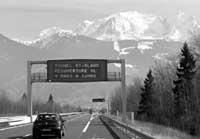
Three years and four months have not been able to enter, but the big trucks already have, as before, the possibility of using the tunnel of Mont Blanc. It can be thought that the truckers are satisfied with the decision, since they can use a more road linking Italy and France. Most of those who live on both sides of the tunnel have become angry.
After three years of closure, the Mont Blanc tunnel was reopened on 9 March. Three years earlier, the Mont Blanc tunnel suffered a serious accident that forced the tunnel to close. Around 11 a.m. on March 24, 1999, a truck traveling from Italy to France was set on fire. The fire produced a large smoke until the tunnel was blocked. As a result, 39 people lost their lives.
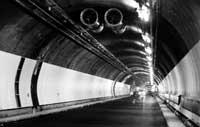
The Mont Blanc tunnel was first opened in 1965 to connect the Haute Savon of France with the Italian valleys of Aosta. Next to the Frejus tunnel, it is the only tunnel of the Alps connecting these two countries. It has a length of 11 kilometers and 600 meters and a width of 8 meters and 60 centimeters, but the width of the road is 7 meters. The entrance to France is 1.274 meters and that of Italy of 1.381, reaching the highest point of the tunnel almost 1.396 meters.
Among the causes of the 1999 accident, the scant safety status of the tunnel is mentioned. In the renovated tunnel, of course, security measures have been very important, although the basic structure of the tunnel has not been modified. The works of conditioning have supposed 350 million euros.
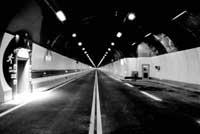
The impact of this great investment is evident. The tunnel is full of lights, with signs, warning places, protection points, etc.
As can be seen, numerous and apparently effective prevention and safety measures have been adopted in the renovated Mont Blanc tunnel. But the inhabitants of Savoia Garaia and the Aosta valley are not very satisfied with the situation.
There is truck circulation at the center of the debate. In fact, on the day of the reopening of the tunnel, on March 9, it was only opened for cars. From April 10, trucks of less than 9 tons could also be used. And this was not to the liking of those who live on both sides of the tunnel, since trucks generate a lot of noise and smoke. As if it were not enough, since the trucks of all kinds began to use the tunnel, at the end of June, residents on both sides of the tunnel say that the tunnel cannot absorb all traffic, since long, already conventional jams have been extended.
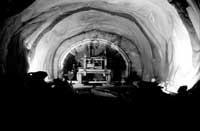
The solution is not easy. In the last three years, since it is not possible to use the Mont Blanc tunnel, the trucks have used the Frejus tunnel to go from France to Italy or vice versa. Of course, the inhabitants of the area also complain that no one likes to be in the middle of the journey of all kinds of trucks.
It is somewhat surprising what happened with the Mont Blanc tunnel. In fact, when Savoia Garaia was closed in the vicinity of Chamonix, and residents in the Aosta valley were frightened by the closure of the tunnel and the decline in the economy. However, the situation was different, as people continued to travel on both sides of the tunnel, to carry out mountain and ski tourism, and also the noise and smoke of the trucks disappeared. The large ones were rediscovered with a unique and forgotten natural environment. For three years they have become accustomed to this form of peace, and now they are not willing to return to the new.
It seems that the solution to the problem can be the railroad. In Switzerland, for example, trucks are taken by train. Although the Lyon-Turin railway is among the priorities of the European Commission, it will take time to become a reality. Therefore, we must take it with patience.
Search for safety in the tunnel
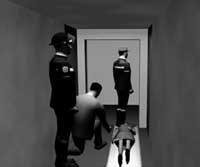
Strict security measures and advanced security systems. These are the main differences between the 1999 tunnel and the current one. In fact, from the time it was decided to renovate the tunnel, the authorities were sure to ensure the safety of the people who were going to cross the tunnel. For this purpose, three years have spent working and it seems that Mont Blanc is a safe tunnel.
In the tunnel of Mont Blanc traffic management measures are very demanding. The minimum distance between two cars is 150 meters and between two buses of 1,200 meters. They control with radical speed and small vehicles travel at a maximum distance of 70 kilometers per hour and minimum of 50 kilometers, while trucks travel at a lower speed.
In the renovated tunnel, the signalling system has become very important. Each 600 meters appear dynamic panels with messages according to the needs. In each direction of the tunnel 20 of this type have been placed. They can also broadcast messages via radio, since they have FM radio inside the tunnel. On the other hand, the fire extinguishers and telephones -safety pits - located every 100 meters are signposted, as are the barriers that cut the circulation of the tunnel every 600 meters, or as the garages that the vehicles can use to make the return inside the tunnel. Each 300 meters is one of them.
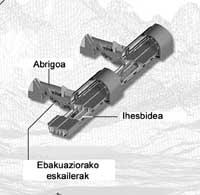
If a vehicle gets damaged and stays in the middle of the tunnel, the guards will see it soon through the video cameras in the control room. They will warn the crane and cut the traffic until the vehicle leaves and the road is clean. In the center of the tunnel there is a security post. There is the infirmary, from where they can also provide the urgent assistance service and where there is also a group of firefighters 24 hours a day.
When there is some obstacle in the tunnel and the vehicles have no other solution to stop and change direction, garages are used. The maneuvers can be cured from the control room, where the tunnel display systems and a total of 120 video cameras are located. From this room, the temperature thermographic detection system and the opaque system for the measurement of smoke are controlled.
One of the most important points of safety in the tunnel is shelters. There is a total of 37. Inside there is space for 50 people, contact telephone with the control room, water, independent ventilation system, fire resistant tools and fire resistant doors. And, most importantly, the outputs that can be used to exit and escape the tunnel, always under the direction of the support teams. Therefore, until help arrives, people can be in shelters.
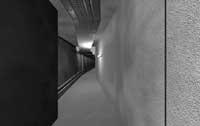
These shelters are interconnected by sections. The Mont Blanc tunnel has 8 pedestrian escapes. Therefore, they can be used to get away from the fire site. Upon arrival of the aid, people who are in the shelter can leave on their own walking. Then, in another place of the tunnel, away from fire and smoke, they will go looking for some vehicle.
These tunnels that are used to escape the fires are narrow, but have a special vehicle for the wounded. This vehicle can circulate peacefully within the narrow tunnel. As in the case of pedestrians, the injured will be transferred to another shelter for their exit. The system seems safe, but the firefighters themselves say that, to be completely safe, the tunnel lacks direct escapes to the outside.
In the fires that occur in the tunnels, smoke is often more harmful than fire, as in addition to drowning people, it can cause accidents and prevent vision. Therefore, the ventilation system is of vital importance. In this tunnel, 116 smoke extractors have been installed that meet the function of fireplace, so each 100 meters is one of them. All of them are controlled from the control room and, if necessary, the extraction force of all of them can be grouped at intervals of 600 meters.
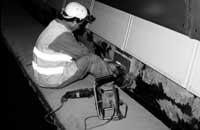
To verify the validity of the system, several tests have been carried out in which it has been confirmed that the smoke, instead of staying in the tunnel, leaves upwards thanks to the extraction system. Under normal conditions, fresh air flows through the interior of the tunnel. The detection system at the beginning of the fire alerts the control room. From there open the chimneys and launch the extractors. In addition, in the fire zone, fresh air is interrupted. The effects of the operation are usually the reduction of smoke, the non-extension and the exit of the prescribed pathway.
To the measures that can be taken from the control room in case of failure or fire must be added the performance of firefighters. As mentioned above, 24 hours a day there is a group of firefighters in the security post of the half tunnel. They have a special truck for their work. It has two cabins with 4 wheel drive to be able to see the infrared camera with smoke, oxygen and, of course, everything you need to face the fire.
Information about information
- To travel the 11 kilometers and 600 meters of the tunnel it takes approximately a quarter of an hour.
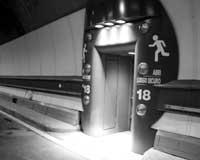 Modern emergency exit.
Modern emergency exit. - XX. At the beginning of the twentieth century, people walked across the Mont Blanc mountain range from France to Italy or from Italy to France. For this, it took three days.
- In 1950 it took three hours to travel the road by car.
- Until 1999 the tunnel management was carried out by two bodies: the French ATMB (Autorute et Tunnel du Mont Blanc) and the Italian SITMB (Societa Italiana del Traforo del Monte Bianco). Now the tunnel management corresponds to a single company, GEIE TMB, successor of the two previous ones.
- Since the opening of the tunnel to the date of the accident (1965-1999), more than 45 million vehicles have crossed the Mont Blanc tunnel, of which 40% have been trucks.
- According to the citizenship of tourists, the accounts are distributed as follows: 47% Italian, 37% French, 9% Swiss, 2% Dutch, 2% British and 3% others.
- As for the citizenship of trucks, the distribution is as follows: 36% French, 31% Italian, 15% Dutch, 10% British, 3% Eastern countries, 2% German and Austrian and 3% others.
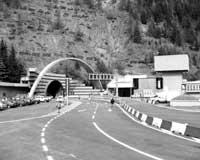 One of the entrances to the Mont Blanc tunnel.
One of the entrances to the Mont Blanc tunnel. - The reopening of the tunnel was 350 million euros, of which 22.5 million have been contributed by the European Union, the rest by the tunnel management company.
- Approximately 500 people participated in the restoration of the tunnel.
Tunnel of Mont Blanc, significant dates
- 1949 The French and Italian governments signed an agreement for the construction of the tunnel.
- 1957 STMB (Societé du tunnel du Mont Blanc) was created to manage the tunnel.
- 1959 Construction works of the tunnel begin.
- 1962 The French and Italian groups that were excavating joined together.
- 1965 Inauguration and official opening of the tunnel. In the action participated De Gaull and Giuseppe Saragata.
- 1999 (March), the accident and fire occurred. They had to close the tunnel.
- 1999 (December), approval of the tunnel renovation project.
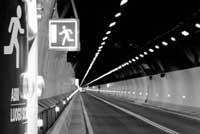
- 2000 (February-March), Dismantling of ruinous installations.
- 2000 (April-july), Decontamination and cleaning were carried out.
- 2000 (August-September), security measures are established for the execution of the work.
- 2000-2001 (September-August), with engineering works.
- 2001 (September-November) Installation of safety equipment inside the tunnel.
- 2001-2002 (November-January), Tests, exercises…
- 2002 (March), reopening of the tunnel except for large trucks.
- 2002 (June), the use of the tunnel for vehicles of all sizes is authorized.
Published in section D2 of the call.
Buletina
Bidali zure helbide elektronikoa eta jaso asteroko buletina zure sarrera-ontzian











